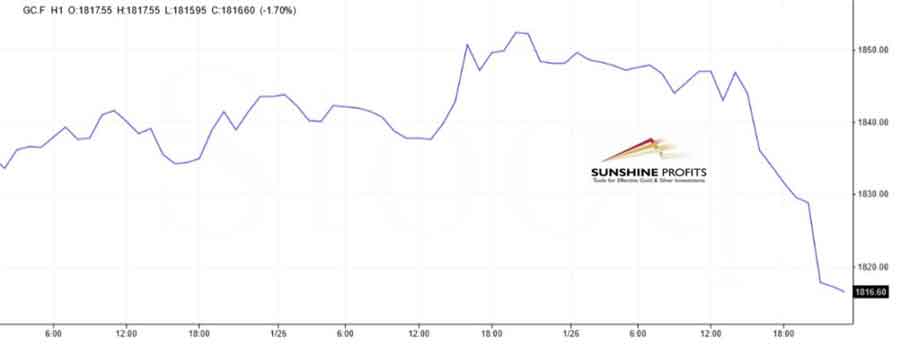Send this article to a friend:
January
29
2022

Send this article to a friend: January |
 |
Gold Plunged But Didn’t Collapse Under The Hawkish Fed
The Battlecruiser Hawk is moving full steam ahead! The FOMC issued yesterday (January 26, 2022) its newest statement on monetary policy in which it strengthened its hawkish stance. First of all, the Fed admitted that it would start hiking interest rates “soon”:
Previously, the US central bank conditioned its tightening cycle on the situation in the labor market. The relevant part of the statement was as follows in December:
The alteration implies that, in the Fed’s view, the US economy has reached maximum employment and is ready to lift the federal funds rate. Indeed, Powell reaffirmed it, saying:
Powell also clarified the timing, stating that “the Committee is of the mind to raise the federal funds rate at the March meeting.” This is not completely unexpected, but does mark a significant hawkish change in the Fed’s communication, which is negative for gold. Second, the FOMC reaffirmed its plan, announced in December, to end quantitative easing in early March. It means that in February, the Fed will buy only $20 billion of Treasuries and $10 billion of agency mortgage-backed securities, instead of the $40 and $20 purchased in January:
Third, the FOMC is preparing for quantitative tightening. Together with the statement on monetary policy, it published “Principles for Reducing the Size of the Federal Reserve’s Balance Sheet”. The Fed hasn’t yet determined the timing and pace of reducing the size of its mammoth balance sheet. However, we know that it will happen after the first hike in interest rates, so probably as soon as May or June. After all, as Powell admitted during his press conference, “the balance sheet is substantially larger than it needs to be (…). There’s a substantial amount of shrinkage in the balance sheet to be done.” Implications for Gold What does the recent FOMC statement imply for the gold market? The end of QE, the start of the hiking cycle, and then of QT – all packed within just a few months – is a big hawkish wave that could sink the gold bulls. The Fed hasn’t been so aggressive for years. Of course, maybe it’s just a great bluff, and the Fed will retreat to its traditional dovish stance soon when tightening monetary and financial conditions hit Wall Street and the real economy. However, with CPI inflation above 7%, mounting political pressure, and public outrage at costs of living, the US central bank has no choice but to tighten monetary policy, at least for the time being. It seems that gold got the message. The price of the yellow metal plunged more than $30 Wednesday, as the chart below shows. Interestingly, gold started its decline before the statement was published, which may indicate more structural weakness. What is also disturbing is that gold was hit even though the FOMC statement came largely as expected. 
On the other hand, gold didn’t collapse, but it dropped only by thirty-some dollars, or about 1.6%. Given the importance and hawkishness of the FOMC meeting, it could have been worse. Yes, the hawkish message was expected, and some analysts even forecasted more aggressive actions, but gold clearly didn’t capitulate. Thus, there is hope (and turbulence in the stock market can also help here), although the upcoming weeks may be challenging for gold, which would have to deal with rising bond yields. If you enjoyed today’s free gold report, we invite you to check out our premium services. We provide much more detailed fundamental analyses of the gold market in our monthly Gold Market Overview reports, and we provide daily Gold & Silver Trading Alerts with clear buy and sell signals. To enjoy our gold analyses in their full scope, we invite you to subscribe today. If you’re not ready to subscribe yet, and you are not on our gold mailing list yet, we urge you to sign up there as well for daily yellow metal updates. Sign up now! Arkadiusz Sieron, PhD —– Disclaimer: Please note that the aim of the above analysis is to discuss the likely long-term impact of the featured phenomenon on the price of gold and this analysis does not indicate (nor does it aim to do so) whether gold is likely to move higher or lower in the short- or medium term. In order to determine the latter, many additional factors need to be considered (i.e. sentiment, chart patterns, cycles, indicators, ratios, self-similar patterns and more) and we are taking them into account (and discussing the short- and medium-term outlook) in our Gold & Silver Trading Alerts.
|
Send this article to a friend:
 |
 |
 |